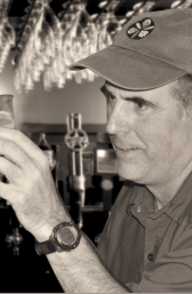Start 14-Day Trial Subscription
*No credit card required

Mike Stevens and Dave Engbers
BC: Your brewery history on the website tells the story of how you had to do an early course correction for the brewery by changing the lineup of beers you offered.
Mike: Basically what happened was we wrote our business plan in 1994 and quit our jobs and said this is what we are doing. By 1997 we opened up and sold our first case.
About three years into it we started running into bankruptcy problems. The landlord called and said ‘You’ve got a week then we’re going to put a chain on the door, unless of course you can make whole on a $200,000 commitment.’ The bank called our note and that was about $350,000 we owed there. I hadn’t paid Federal excise tax in a while so they started chasing. So if we are going down why don’t we start brewing beers we want to drink? I mean this shit’s not working we might as well go out punching. We miraculously fixed the financial problems and found investors in that week’s time.
My first 12 years all I did was hit the streets looking for investments, but we found some in that week where one ponied up to guarantee the loan and another couple bailed us out on the lease. So we restructured everything and reinvented Founders. We went away from the wheat beer, amber, and pale ale and we invented Dirty Bastard. In a conservative community where most of investors were 55, 60 or even older, they thought we were just idiots. ‘You have a name like that; you have a big, dark high gravity beer. Who the hell is going to drink that kind of thing?’ As soon as it came out all of a sudden we saw our sales immediately climb.
Quickly then we came out with the Curmudgeons and Devil Dancers and Breakfast Stouts. Over that 3 year period that’s when we became Founders; when we were on the forefront of what is considered the extreme beer movement. It became the hot thing and we were one of the half dozen pioneers. In a week we came up with a new path and a half million dollars. That’s why “Brewed For Us” means so much. I argue to this day that extreme beer catapulted craft beer forward and excited the consumers. They started scratching their heads saying ‘Holy cow! They have chocolate, coffee, raspberry and oatmeal in that beer. I’ve never heard of anything like that.’
Dave: I said. ‘We need to do something bigger and bolder but it can’t be too bitter. I think we should do a big malt bomb.’ I literally opened up the BJCP Guidelines and started looking at different styles and circled a handful that I thought would work. I said you know I think we should do a Scotch Ale it fits the bill. Fairly quickly we came up with a recipe. I think we tweaked it a couple of times. Once we hit with Dirty Bastard a couple of things happened. One, we didn’t use Founders Pale Ale, Founders Amber Ale, we used Dirty Bastard. It was a little sexier and the liquid was amazing. It was different and it was unique. It didn’t have a lot of competition out there. People didn’t necessarily know what a Scotch Ale was but they fell in love with it because it was a big, robust malt bomb and the fact that it had a name like Dirty Bastard didn’t hurt it.
Once we made that decision we started getting some attention fairly rapidly and one thing we did pretty quickly was to say alright from this day forward we are going to be a product driven company. We aren’t going to listen to our investors. We are making all these calls now. Everything we are going to do from this day forward is going to be bigger and bolder, more complex with bigger aromatics. Soon afterwards that’s when Breakfast Stout came out. Curmudgeon Old Ale came out. Devil Dancer came out. That’s when things finally started to get fun.




Comments
Pages